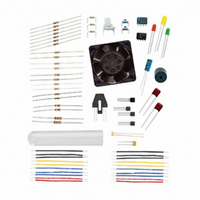130-28176 Parallax Inc, 130-28176 Datasheet - Page 299

130-28176
Manufacturer Part Number
130-28176
Description
KIT PARTS PROCESS CONTROL
Manufacturer
Parallax Inc
Specifications of 130-28176
Accessory Type
Education Kit
Product
Microcontroller Accessories
Lead Free Status / RoHS Status
Contains lead / RoHS non-compliant
For Use With/related Products
Board of Education Full Kit
Lead Free Status / RoHS Status
Lead free / RoHS Compliant, Contains lead / RoHS non-compliant
- Current page: 299 of 330
- Download datasheet (11Mb)
closer the actual temperature got to the setpoint, the less drive that proportional supplied.
If the temperature actually reached the setpoint, the total drive would be 50 %, all due to
bias. However, from previous activities, we found that 50% drive would result in a
temperature of 98 °F.
In order for proportional drive to have control, there must be error. With a K
amount of error allowed a stable temperature around 100 °F. This error is called "Steady-
State Error."
When K
resulting in a temperature even closer to the setpoint. At 1.0, the steady-state temperature
was even closer, but oscillations are beginning. Finally, with a K
closer but had heavy oscillations, and as can be seen, the midpoint of the oscillations are
still below the setpoint.
If bias drive is not correct for the setpoint, proportional drive alone cannot maintain
temperature at the setpoint. Proportional drive is good for driving the system back
towards the setpoint, but there needs to exist error for proportional drive to have effect.
Of course, the logical thing to do would be to adjust the bias to meet the conditions. In
this case changing bias to 70% may provide sufficient energy. But what happens when
the conditions change again? We are back to manual control at the setpoint.
Challenge 8-4
An oil flow system is designed and it is found that 80% drive is needed to drive the pump
for the required flow rate.
1. If bias were set to 50%, would the flow stabilize above or below the setpoint?
2. How would increasing the proportional gain affect the steady state flow rate?
3. How would decreasing the proportional gain affect the steady state flow rate?
P
was increased to 0.5, this increased the proportional drive for the same error
P
of 2.0, it drove even
P
of 0.1, the
Related parts for 130-28176
Image
Part Number
Description
Manufacturer
Datasheet
Request
R

Part Number:
Description:
KIT PROPELLER EDU PROJECT PARTS
Manufacturer:
Parallax Inc
Datasheet:

Part Number:
Description:
KIT PARTS SMART SENSORS
Manufacturer:
Parallax Inc
Datasheet:

Part Number:
Description:
Microcontroller Modules & Accessories DISCONTINUED BY PARALLAX
Manufacturer:
Parallax Inc

Part Number:
Description:
BOOK UNDERSTANDING SIGNALS
Manufacturer:
Parallax Inc
Datasheet:

Part Number:
Description:
COMPETITION RING FOR SUMOBOT
Manufacturer:
Parallax Inc
Datasheet:

Part Number:
Description:
TEXT INFRARED REMOTE FOR BOE-BOT
Manufacturer:
Parallax Inc
Datasheet:

Part Number:
Description:
Microcontroller Modules & Accessories DISCONTINUED BY PARALLAX
Manufacturer:
Parallax Inc

Part Number:
Description:
BOOK UNDERSTANDING SIGNALS
Manufacturer:
Parallax Inc
Datasheet:

Part Number:
Description:
BOARD EXPERIMENT+LCD NX-1000
Manufacturer:
Parallax Inc
Datasheet:

Part Number:
Description:
IC MCU 2K FLASH 50MHZ SO-18
Manufacturer:
Parallax Inc
Datasheet:













